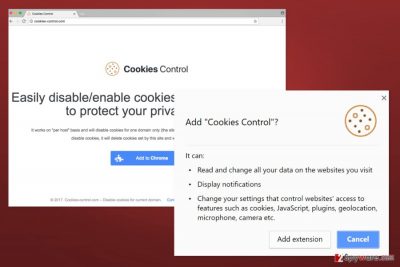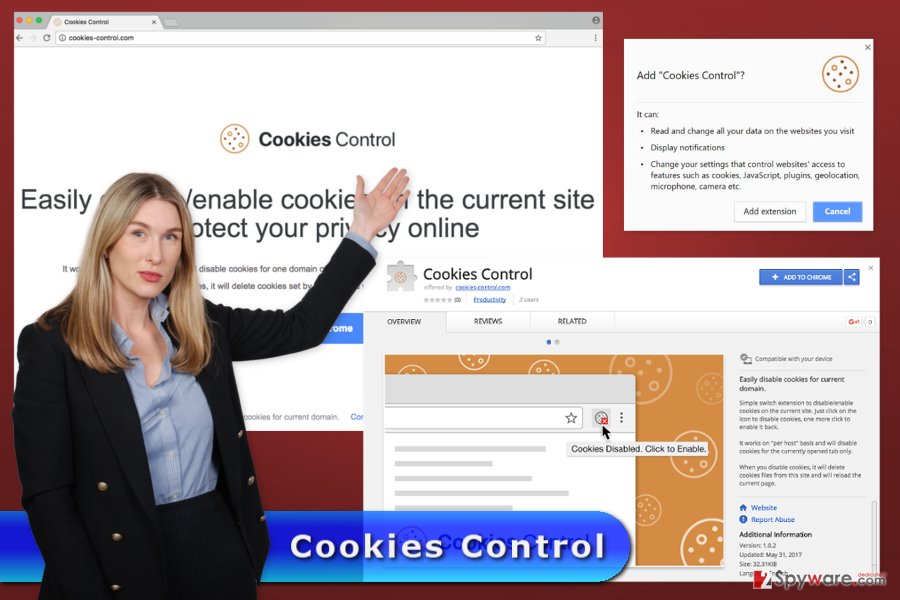Cookies Control virus (Free Guide) - Virus Removal Instructions
Cookies Control virus Removal Guide
What is Cookies Control virus?
Cookies Control overloads you with troublesome notifications

Cookies Control functions as and adware application that is available as a browser extension in Google Chrome Web store.[1] It supposedly enables netizens to monitor cookies on various websites.
The add-on might seem practical for those who are concerned about online privacy. Nonetheless, after the installation, the so-called Cookies Control virus shows its real face. Your browser might turn into digital billboard and crash due to the excessive amount of online ads.
In the Privacy Policy, developers tell that they do not track user’s behavior online. However, display third-party advertisements and advertisers might be interested in using cookies to know you better.
Therefore, even if you install this browser extension, you will not protect yourself from curious advertisers. Thus, you might soon start seeing targeted ads that might be based on your browsing history.
For instance, if you have looked for holiday destinations, you might find ads offering to stay in various hotels in Spain, France[2] or other destinations.
However, some of the Cookies Control ads are absolutely legitimate and safe; some of them raise doubts. The problem is that you can never be sure whether it’s legit or a harbinger of a virtual threat.
This browser add-on might deliver ads that lead to misleading websites that want to get your personal details or offer to install bogus software.
Users also report that once they installed Cookies Control, they experienced redirects to various promotional websites. However, the research has shown that adware might be capable of redirecting even to tech support scam or phishing[3] sites too.
Many developers of the free programs generate revenue from advertising. However, some of them put user’s interests to the second plan. This browser extension might flood your browser with commercial content and prevent from browsing the web without distractions. It’s pretty good reason to remove Cookies Control from your browser.
However, if you haven’t installed it directly, you should also scan your PC with reputable anti-malware, such as FortectIntego.
This PUP may arrive at the system in a software bundle silently. Thus, other undesired apps may have been install as well. In this case, automatic Cookies Control removal helps to get rid of all suspicious applications.

Distribution and prevention of PUPs
Nevertheless, the extension has an official website and is distributed on Chrome store; it might appear on the browser unexpectedly.
Developers of this free application rely on bundling strategy that allows spreading PUP as an optional component in freeware or shareware packages.The Cookies Control hijack might occur when users download such programs under Quick/Recommended setup.
These settings usually do not reveal about optional applications and install them by default. To avoid PUPs, you have to install new programs with Advanced/Custom settings. Once you see the list of pre-selected entries, untick them all. Then you can be sure that you won’t encounter annoying after-effects of Cookies Control redirect phenomenon.
Incorrect software installation may let various adware, browser hijackers and other suspicious programs to get inside your PC and cause plenty other problems.
Cookies Control elimination options
In order to get rid of undesired and annoying ads, you have to remove Cookies Control from the browser. If you have installed this program on your own, carefully uninstall it and all related extensions.
If this add-on arrived in the software bundle, you have to check whether other programs haven’t been installed on your PC or browsers.
Manual Cookies Control removal instructions below will help you to investigate the system and terminate suspicious entries. However, you can speed up its removal with the help of updated security tool.
You may remove virus damage with a help of FortectIntego. SpyHunter 5Combo Cleaner and Malwarebytes are recommended to detect potentially unwanted programs and viruses with all their files and registry entries that are related to them.
Getting rid of Cookies Control virus. Follow these steps
Uninstall from Windows
If Cookies Control appeared on your browser without your knowledge, you should follow the steps below carefully and make sure that any suspicious programs haven't been installed as well.
Instructions for Windows 10/8 machines:
- Enter Control Panel into Windows search box and hit Enter or click on the search result.
- Under Programs, select Uninstall a program.

- From the list, find the entry of the suspicious program.
- Right-click on the application and select Uninstall.
- If User Account Control shows up, click Yes.
- Wait till uninstallation process is complete and click OK.

If you are Windows 7/XP user, proceed with the following instructions:
- Click on Windows Start > Control Panel located on the right pane (if you are Windows XP user, click on Add/Remove Programs).
- In Control Panel, select Programs > Uninstall a program.

- Pick the unwanted application by clicking on it once.
- At the top, click Uninstall/Change.
- In the confirmation prompt, pick Yes.
- Click OK once the removal process is finished.
Delete from macOS
If this browser extension surprised you with the appearance, you should check the list of installed applications. If you see some suspicious entries, uninstall them immediately.
Remove items from Applications folder:
- From the menu bar, select Go > Applications.
- In the Applications folder, look for all related entries.
- Click on the app and drag it to Trash (or right-click and pick Move to Trash)

To fully remove an unwanted app, you need to access Application Support, LaunchAgents, and LaunchDaemons folders and delete relevant files:
- Select Go > Go to Folder.
- Enter /Library/Application Support and click Go or press Enter.
- In the Application Support folder, look for any dubious entries and then delete them.
- Now enter /Library/LaunchAgents and /Library/LaunchDaemons folders the same way and terminate all the related .plist files.

Remove from Microsoft Edge
Delete unwanted extensions from MS Edge:
- Select Menu (three horizontal dots at the top-right of the browser window) and pick Extensions.
- From the list, pick the extension and click on the Gear icon.
- Click on Uninstall at the bottom.

Clear cookies and other browser data:
- Click on the Menu (three horizontal dots at the top-right of the browser window) and select Privacy & security.
- Under Clear browsing data, pick Choose what to clear.
- Select everything (apart from passwords, although you might want to include Media licenses as well, if applicable) and click on Clear.

Restore new tab and homepage settings:
- Click the menu icon and choose Settings.
- Then find On startup section.
- Click Disable if you found any suspicious domain.
Reset MS Edge if the above steps did not work:
- Press on Ctrl + Shift + Esc to open Task Manager.
- Click on More details arrow at the bottom of the window.
- Select Details tab.
- Now scroll down and locate every entry with Microsoft Edge name in it. Right-click on each of them and select End Task to stop MS Edge from running.

If this solution failed to help you, you need to use an advanced Edge reset method. Note that you need to backup your data before proceeding.
- Find the following folder on your computer: C:\\Users\\%username%\\AppData\\Local\\Packages\\Microsoft.MicrosoftEdge_8wekyb3d8bbwe.
- Press Ctrl + A on your keyboard to select all folders.
- Right-click on them and pick Delete

- Now right-click on the Start button and pick Windows PowerShell (Admin).
- When the new window opens, copy and paste the following command, and then press Enter:
Get-AppXPackage -AllUsers -Name Microsoft.MicrosoftEdge | Foreach {Add-AppxPackage -DisableDevelopmentMode -Register “$($_.InstallLocation)\\AppXManifest.xml” -Verbose

Instructions for Chromium-based Edge
Delete extensions from MS Edge (Chromium):
- Open Edge and click select Settings > Extensions.
- Delete unwanted extensions by clicking Remove.

Clear cache and site data:
- Click on Menu and go to Settings.
- Select Privacy, search and services.
- Under Clear browsing data, pick Choose what to clear.
- Under Time range, pick All time.
- Select Clear now.

Reset Chromium-based MS Edge:
- Click on Menu and select Settings.
- On the left side, pick Reset settings.
- Select Restore settings to their default values.
- Confirm with Reset.

Remove from Mozilla Firefox (FF)
Remove dangerous extensions:
- Open Mozilla Firefox browser and click on the Menu (three horizontal lines at the top-right of the window).
- Select Add-ons.
- In here, select unwanted plugin and click Remove.

Reset the homepage:
- Click three horizontal lines at the top right corner to open the menu.
- Choose Options.
- Under Home options, enter your preferred site that will open every time you newly open the Mozilla Firefox.
Clear cookies and site data:
- Click Menu and pick Settings.
- Go to Privacy & Security section.
- Scroll down to locate Cookies and Site Data.
- Click on Clear Data…
- Select Cookies and Site Data, as well as Cached Web Content and press Clear.

Reset Mozilla Firefox
If clearing the browser as explained above did not help, reset Mozilla Firefox:
- Open Mozilla Firefox browser and click the Menu.
- Go to Help and then choose Troubleshooting Information.

- Under Give Firefox a tune up section, click on Refresh Firefox…
- Once the pop-up shows up, confirm the action by pressing on Refresh Firefox.

Remove from Google Chrome
Carefully look through the list of Chrome's extensions. You should find Cookies Control. Thus, you have to remove it as any other add-on. However, you find other unknown entries, you should get rid of them too.
Delete malicious extensions from Google Chrome:
- Open Google Chrome, click on the Menu (three vertical dots at the top-right corner) and select More tools > Extensions.
- In the newly opened window, you will see all the installed extensions. Uninstall all the suspicious plugins that might be related to the unwanted program by clicking Remove.

Clear cache and web data from Chrome:
- Click on Menu and pick Settings.
- Under Privacy and security, select Clear browsing data.
- Select Browsing history, Cookies and other site data, as well as Cached images and files.
- Click Clear data.

Change your homepage:
- Click menu and choose Settings.
- Look for a suspicious site in the On startup section.
- Click on Open a specific or set of pages and click on three dots to find the Remove option.
Reset Google Chrome:
If the previous methods did not help you, reset Google Chrome to eliminate all the unwanted components:
- Click on Menu and select Settings.
- In the Settings, scroll down and click Advanced.
- Scroll down and locate Reset and clean up section.
- Now click Restore settings to their original defaults.
- Confirm with Reset settings.

Delete from Safari
Remove unwanted extensions from Safari:
- Click Safari > Preferences…
- In the new window, pick Extensions.
- Select the unwanted extension and select Uninstall.

Clear cookies and other website data from Safari:
- Click Safari > Clear History…
- From the drop-down menu under Clear, pick all history.
- Confirm with Clear History.

Reset Safari if the above-mentioned steps did not help you:
- Click Safari > Preferences…
- Go to Advanced tab.
- Tick the Show Develop menu in menu bar.
- From the menu bar, click Develop, and then select Empty Caches.

After uninstalling this potentially unwanted program (PUP) and fixing each of your web browsers, we recommend you to scan your PC system with a reputable anti-spyware. This will help you to get rid of Cookies Control registry traces and will also identify related parasites or possible malware infections on your computer. For that you can use our top-rated malware remover: FortectIntego, SpyHunter 5Combo Cleaner or Malwarebytes.
How to prevent from getting adware
Stream videos without limitations, no matter where you are
There are multiple parties that could find out almost anything about you by checking your online activity. While this is highly unlikely, advertisers and tech companies are constantly tracking you online. The first step to privacy should be a secure browser that focuses on tracker reduction to a minimum.
Even if you employ a secure browser, you will not be able to access websites that are restricted due to local government laws or other reasons. In other words, you may not be able to stream Disney+ or US-based Netflix in some countries. To bypass these restrictions, you can employ a powerful Private Internet Access VPN, which provides dedicated servers for torrenting and streaming, not slowing you down in the process.
Data backups are important – recover your lost files
Ransomware is one of the biggest threats to personal data. Once it is executed on a machine, it launches a sophisticated encryption algorithm that locks all your files, although it does not destroy them. The most common misconception is that anti-malware software can return files to their previous states. This is not true, however, and data remains locked after the malicious payload is deleted.
While regular data backups are the only secure method to recover your files after a ransomware attack, tools such as Data Recovery Pro can also be effective and restore at least some of your lost data.
- ^ What are browser extensions and how they affect your privacy?. Betternet Blog. The blog about privacy news.
- ^ Lesvirus. Lesvirus. French site about malware, security news and virus removal.
- ^ What are phishing scams and how can I avoid them?. Knowledge Base. Indiana University official site.























